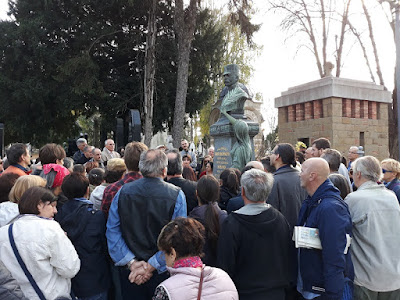In a view of the
WWI Armistice Centenary, two more guided strolls devoted to this important
historical event were organized at the New Cemetery of Belgrade on November 4
and November 18, 2018.
Legendary WWI Military Commanders and Heroes Buried at the New Cemetery
Legendary WWI Military Commanders and Heroes Buried at the New Cemetery
This guided
stroll through the New Cemetery was devoted to immense courage, sacrifice and
patriotism of the Great War participants. In the course of this inspiring
stroll, our guide revived the memories of Legendary Serbian WWI Military Commanders,
famous filed marshals, generals and majors, but also all those known and
unknown man and women who significantly contributed to the Serbian WWI effort.
One of the focuses of this stroll was the Memorial Ossuary of Belgrade
Defenders (1914-1918), where the visitors were able to enter the crypt beneath
the monument. This informative tour revealed many aspects of the Great War:
locations, strategies, battles, and events, in addition to many intimate
stories of hopes, fears, anger, pain, suffering, patriotism and love.
Serbian She-Soldiers and Volunteer Nurses in the Great War
Our visitors who
showed up in significant number, disregarding the cold weather and the first
snow, were able to hear emotional stories on the women in Great War. The stories were related to the courageous
she-soldiers who defended their country and were widely admired by the
international community and press, but also the women who interrupted their
successful careers or studies abroad to act as volunteer nurses or humanitarian
workers, tending to the wounded at the battle fields or tirelessly travelling
through the world, gathering aid in order to help their compatriots in these
times of temptation.
We would like to share a story about a local lady, almost
forgotten today, who played a significant role during the first days of the
Great War in Belgrade. In spite of being a middle-class home maker, Vuka
Popadic was considered one of the bravest citizens of Belgrade at the time.
Upon first siege of Belgrade in the Great War, she started to gather around the
hungry and frightened citizens of Belgrade. At her flat in down-town Belgrade,
which was the center of military action, she organized an improvised field
hospital, providing the first aid to the wounded soldiers and civilians and helping
them to survive to the nearest hospitals. She even managed to capture a group
of fifteen Austro-Hungarian soldiers, whom she later surrendered to the Serbian
Army, but only after sheltered them in the safety of her home and treating them
with fruit preserve (loc.: “slatko”) and fresh water in accordance with the
local customs. 



